Volume 4 Number 2
©The Author(s) 2002
Modeling Collaboration, In-Depth Projects, and Cognitive Discourse: A Reggio Emilia and Project Approach Course
Abstract
This article discusses two early childhood professors' experience of teaching a weeklong collaborative course on Reggio Emilia, the Project Approach, and documentation. Principles of adult learning were used as a foundation to structure and organize the course, in which students applied their knowledge and skills to in-depth investigation of projects and documentation of learning. The article discusses issues of conflict that emerged among group members and reflects upon conditions needed to support intellectual discourse. Final reflections from the students and professors are highlighted.
Introduction
We are early childhood education professors teaching in programs at two different institutions of higher education in Montana. While engaging in lively discussions of current issues and practices in early childhood education, we discovered our mutual, complementary interests and began to explore the idea of offering a team-taught summer intensive course to early childhood students and practitioners. We wanted to introduce students to the history, framework, principles, concepts, and experiences of Reggio Emilia, the Project Approach, and documentation; to highlight their commonalities and differences; to share current research and practices; and to assist students in transforming their knowledge into practice. This article is the story of our collaborative experiences, challenges, and reflections.
Teaching the course described in this article was our first experience at collaborating. We met over a period of weeks to design the course. During this time, we embraced the ideas of shared decision making and taking responsibility for determining the content, assignments, structure, and organization of the course. We learned that an attitude of openness, trust, and support was necessary to achieve our goals and outcomes. We began to prepare for the course using the principles and practices of early childhood education and adult learning as a foundation. We were eager to offer a course for adults that required them to learn in ways that children in their classes are required to learn (Duckworth, 1996).
The course was held for five days at Birch Creek Education Center, a former Conservation Corps Camp, located on several hundred acres nestled in the remote southwestern mountains of Montana. Thirty students stayed in dormitory-style rooms and cabins and shared meals in the main lodge. The natural beauty of the area featured forests, geological formations, creeks, ponds, lakes, wildflowers, natural vegetation, animals, and hiking trails, thus providing many opportunities for retreat, exploration, interaction, and reflection. Other features of the setting included a common meeting room, a classroom warmed with a wood-burning stove, and a large "studio" that was aesthetically arranged with a selection of resources. The participants from across Montana included active practitioners and traditional students, with educational levels ranging from first college experiences to the pursuit of master's degrees.
Adult Learning
As early childhood professors and adult educators, we subscribe to the adult learning theory andragogy, popularized by Malcolm Knowles (1984). This theory views adults as self-directed learners, motivated by intrinsic rather than extrinsic rewards, who bring a multitude of life experiences into the learning situation. According to Knowles, it is not only ineffective to ignore this previous experience and knowledge, but it also is damaging because an adult's identity is closely tied to his or her experience. Learning occurs more readily when the information is relevant to the learner, immediately applied, and problem centered. "Adults become ready to learn those things they need to know and be able to do in order to cope more effectively with their real-life situations" (Knowles, 1984, p. 58). Andragogy stresses collaborative, experiential techniques such as inquiry, labs, and simulations. The role of the teacher is to facilitate learning. "The educator has a responsibility to create conditions and provide tools and procedures for helping learners discover their 'needs to know'" (Knowles, 1980, p. 44). The teacher establishes a physical and psychological climate based upon humanness, including mutual respect and trust, collaboration, authenticity, openness, and pleasure.
Adult learning experiences were supported with lectures, small group discussions, audiovisual presentations, engagement in fieldwork and investigation, documentation of projects, and a culminating event. Consistent with andragogy, we preassessed students' background knowledge and previous experiences and used this information in developing the course. Student decision making and cooperative learning were core components of the experience. The "need to know" was enhanced through hands-on investigation with immediate opportunities to apply knowledge and skills. Students were learning about Reggio Emilia, the Project Approach, and documentation while concurrently engaging in project work. Participating in project work not only created "a need to know" but also an opportunity to reflect upon the experiences from a learner's point of view. Night sessions provided options for viewing videos, discussing issues around the campfire, writing in journals, and revisiting project work. In addition, students were required to complete a precourse information sheet; read books and articles; visit Web sites; complete a precourse paper assignment; keep a daily journal; complete a postcourse plan for implementing the Project Approach in an early childhood setting; and subscribe to an electronic discussion list for the purpose of exchanging information and sharing resources, challenges, and ideas after the course had ended.
 Around the
campfire.
Around the
campfire.
Our approach to adult learning, andragogy, was consistent with many beliefs and practices espoused by the Reggio Emilia approach and the Project Approach. These practices include the emphasis on cooperation, "learning by doing," making learning relevant and meaningful to learners, and encouraging learner self-direction and control of the learning situation.
Getting Started
The first phase of the course focused on an introduction to the Reggio Emilia approach and the Project Approach. Before the course began, students read First Steps toward Teaching the Reggio Way (Hendrick, 1997), Young Investigators: The Project Approach in the Early Years (Helm & Katz, 2001), and Spreading the News: Sharing the Stories of Early Childhood Education (Carter & Curtis, 1996). As a preassessment, students were given large sheets of paper and markers and were requested to symbolically represent their knowledge of the approaches through pictures, words, and graphs. We reviewed their representations and precourse paper assignment to determine their current knowledge, understandings, and misconceptions, and we adapted course content as needed. During the institute, students were asked to revisit their representations and add to them. Following the exercise, we engaged in a discussion of the history, foundation, and basic principles of the Reggio Emilia approach (Gandini, 1997a; 1997b), followed by a viewing of a video of children investigating a poppy project in a school in Reggio Emilia (The Creative Spirit; see http://ecap.crc.illinois.edu/poptopics/reggio/regvid.html for information on the video).
The following comments and questions made by students reflected challenges and issues in adapting and adopting innovations to their current settings and situations:
- Can project work be accomplished and still meet all the Head Start requirements?
- How can this approach work with the ratio of children we care for?
- What about using this approach with infants and toddlers?
- We have to submit our themes for the coming year before the children begin. How will this requirement coincide with practices based upon Reggio Emilia?
- We are allowed to have a theme last only for one week. Can I still use this approach?
We noted the students' interests so that we could address them in the next several days.
We shared with students the historical and theoretical similarities and differences between the Reggio Emilia approach and the Project Approach. For example, we examined the principles of the Reggio Emilia approach, including the image of the child; the role of teachers, space, and parents; the importance of relationships, cooperation, and collaboration; issues of time and continuity; emergent curriculum; languages of children; the importance of projects; and the power of documentation. We asked students to reflect upon those concepts that were a part of their programs and noted that many of them originated in the United States through the influences of theorists such as Dewey, Piaget, and Vygotsky. However, through careful observation, analysis, and research, educators in Reggio Emilia have continued to create new ideas related to their teaching (Gandini, 1997a; Malaguzzi, 1998). We continued our discussion by sharing with students that both the Reggio Emilia approach and the Project Approach stress young children's in-depth investigation of topics of interest to them, and we highlighted the purposes and benefits of project work. Project work gives young children opportunities to investigate significant topics, events, and phenomena in their environments worth learning about and helps to strengthen their curiosity and intellectual dispositions as they apply social, scientific, literacy, creative, and numeracy skills. Children work in small groups, identify questions of interest, and find answers to their questions through investigating, doing fieldwork, creating representations, experimenting, and using resources (Katz & Chard, 2000).
Selecting Topics and Documenting Project Work
The distinctions between themes and topics were a fairly new idea for many of the students, thus we spent a fair amount of time discussing these differences. We began by asking students to share how activities and experiences in their settings are currently organized and determined. Following the discussion, guidelines and practical considerations for selecting topics were shared by asking several questions (see Appendix I). We pointed out that topics can be initiated by the teacher or can emerge from children's interest. Because of the context of the setting and the practical considerations of providing the necessary resources, we identified three fairly broad topics in advance of the course: water, rocks, and plants. Students selected the topic of interest to them and divided themselves into groups of four to six to engage in their project work and documentation. In the evenings, students had the option of viewing videos to increase their understanding of projects (e.g., 100 Languages of Children, Setting Sail, To Make a Portrait of a Lion, Amusement Park for Birds, A Message from Malaguzzi, and The Long Jump; see http://ecap.crc.illinois.edu/poptopics/reggio/regvid.html for information on the videos).
We next explored ways of documenting children's learning through the use of portfolios and documentation panels. One of the important contributions of the Reggio Emilia approach to early childhood education is the documentation of children's experiences. Documentation focuses intensively on children's experiences, thoughts, and ideas, and documentation may include many forms of representational work, photographs, narratives, and transcriptions of their comments. Although the students had varied experiences with creating children's displays and bulletin boards, taking photographs of children's works, writing narratives and transcriptions, and collecting and displaying children's works, they developed a greater understanding of the depth and breadth of the purposes of documentation.
Katz and Chard (1996) note that documentation supports many important educational processes. Documentation gives children an opportunity to review their accomplishments and achievements; this review can foster curiosity, interest, and confidence. The careful thoughts, efforts, and time required to create documentation convey an important message to children—their work and ideas are taken seriously. Teachers can plan and make decisions based upon the documented interests of children as they engage in their project work. Family and community members can be called upon as "experts" and may come to appreciate the child's experience in school. Teachers' attention is focused on children's interests, thus encouraging modification and adjustment of teaching strategies. Through documentation, children's learning becomes concrete and visible.
During the course, we shared patterns that we have observed over the years of working with students on creating documentation panels. Many students and practitioners begin by creating displays of a special event such as a field trip. The next steps may be to add children's transcriptions to the pictures and a record of several experiences occurring during a project. However, Forman and Fyfe (1998) note that these steps are considered a display rather than documentation because they lack commentary—a critical aspect of documentation. "Commentary frames the data as something more general, some principle that can be applied to new concepts. Display invites pleasure and satisfaction, but is not deliberately designed to provoke hypotheses. Documentation is a research report used to enhance discourse rather than a record of past events" (Forman & Fyfe, 1998, p. 246). Documentation often involves examples of children's questions, work, and transcriptions that capture not only children's skills but also their thought processes. Commentary assists the audience in interpretation. Using this information, students critiqued a large selection of displays and documentation panels.
 Viewing
documentation.
Viewing
documentation.
Following the critique exercise, students were introduced to the techniques of webbing and KWHL charts (what we know, what we want to know, how we will find out, and what we learned) to assist in planning and documenting learning. One student stated:
Webs—I have used them in the past and still use them, but I didn't realize how important they can be to help build concepts and connections for children. In a way, I was just using them for myself to help with planning for investigation and research. When using a web at Birch Creek, it helped our group to focus more. We were able to decide what we wanted to know during our short time. However, over extended periods with children, they can help to integrate topics and connect children's interests. They can help children to have "A-ha" moments, when they get the connections.
Each group developed webs and KWHL charts for the group's project. These webs and charts were used as guides for determining questions and directions for research and exploration. Even though there were two or three groups investigating the same broad topic, questions evolved that were unique to each group. For example, one of the groups examining plants was interested in edible wild plants and their medicinal value. Another group was interested in identifying plants, plotting which plants grew in different locations, and determining the effect of terrain on different plants. Groups continued to revisit and revise their webs and KWHL charts as the week progressed, recording new knowledge, skills, dispositions, and emergent interests.
 Rock web.
Rock web.
Students documented their learning throughout the project, presenting documentation panels as part of their culminating event. Photography, using 35-millimeter cameras, was an important part of this documentation. However, when we added digital cameras and color printers, the documentation became richer. Students could immediately see if they had captured the essence of what they wished to photograph. The instant feedback also sparked new explorations. For example, a group of students took a picture in the rain. The instantaneous picture created a fascination with how other items might look when photographed in inclement weather. Many students expressed appreciation at being allowed to experiment with digital cameras. As one student stated, "As I reflected on yesterday's activities, I was so glad that the digital cameras were available for our use. It was so exciting to be able to take a picture and put it to use right away." In final papers, several participants stated that they had requested digital cameras for their classrooms.
Developing the Project
The second phase of the course focused on developing and investigating the project. During this phase, students delved into exploring and finding answers to their questions of interest by spending several hours in the outdoors and, in the process, identified new questions that required further explorations and revisiting. Children (and adults) need to practice and use many skills while engaged in project work, such as asking questions, locating and using resources, observing, sketching on field trips, taking photographs, constructing representations, and using tools and media (Helm & Katz, 2001). Therefore, we wanted to provide the students with many opportunities to experience and practice these skills.
 Heading
out to explore.
Heading
out to explore. 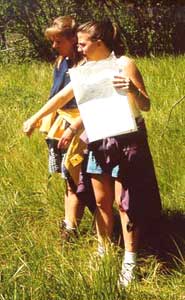 Looking at
natural vegetation.
Looking at
natural vegetation. 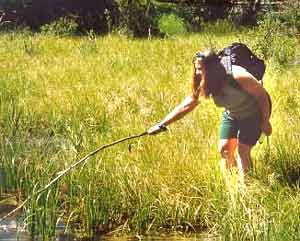 Checking
the water depth.
Checking
the water depth. 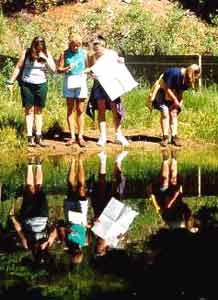 Looking
for pond life.
Looking
for pond life.
Fieldwork and investigations were a critical component of the course. Each day, students were given the opportunity to answer questions from their web or KWHL chart through visiting and revisiting areas of interest. Because questions varied, so did the experiences. Groups might be outdoors with sketchpads drawing, taking pictures with digital cameras, collecting samples, vividly exploring rocks through rock climbing, swimming in an ice-cold mountain lake, graphing different phenomena, or following a stream to its source. Revisiting was a new concept to many of the students; therefore, we discussed the value of revisiting as a way to gather new information, confirm hypotheses, and observe the same place under different conditions.
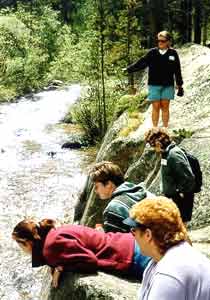 Exploring
rocks and water.
Exploring
rocks and water. 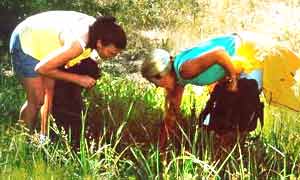 Collecting water samples.
Collecting water samples.
Modeling Reggio Emilia and Project Approach practices, we established a studio to provide opportunities to represent learning and to explore concepts and ideas through a variety of creative media. The studio was practical, aesthetically pleasing, and well stocked with a variety of materials (see Appendix II). Long tables, covered with tablecloths, contained baskets of art media and materials needed for exploration and investigation. Other tables contained resource books to investigate questions, and computers and color printers to assist with documentation.
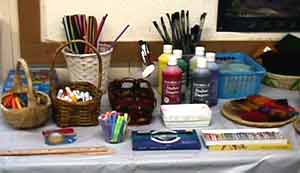 Art materials.
Art materials. 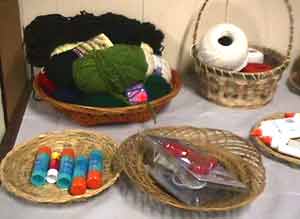 Materials
displayed in baskets.
Materials
displayed in baskets.  Resource
table.
Resource
table.
Students spent many hours in the studio, investigating, documenting, and exploring. Several students had limited exposure to art media such as watercolors, wire, charcoal, or earth clay. Spontaneous lessons often occurred as students taught techniques and shared knowledge with one another.
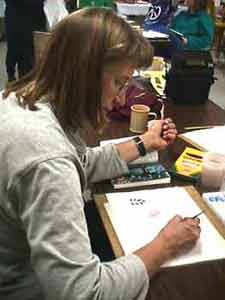 Practicing
with watercolors.
Practicing
with watercolors. 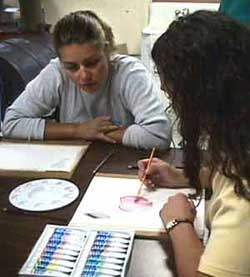 Exploring
shading with watercolors.
Exploring
shading with watercolors. 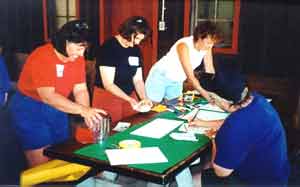 Working
on a group project.
Working
on a group project.
In addition to firsthand experiences, we provided many other resources for answering questions. However, the emergent nature of projects, combined with the lack of phones, Internet connections, libraries, and the one-week time period, made it difficult to always have the research materials and experts the groups desired. Because of these limitations, groups were innovative in locating additional resources by conducting interviews with members of the Birch Creek staff, looking for others in the class who might have the knowledge they desired, and taking advantage of the visiting experts. For example, when a geologist came to give a presentation to another class sharing the setting, members of the rock group interviewed him. Through combining their previous knowledge with exploration at several rich geological areas and investigating their questions using research materials, they had developed a theory for what had caused a particular phenomenon. As one student stated, "It was a wonderful feeling having our theories confirmed by a specialist. It made us grasp the effect the Project Approach would have on children. It is a wonderful, fulfilling, and self-confirming approach." Another group, also studying rocks, became interested in rock climbing. They were able to locate an expert who took them rock climbing and taught them the skill of belaying. As instructors, we had struggled with what to provide in resources, not wanting to limit projects by selecting the experts in advance. We continue to believe that the direction of the project must emerge from the interests within the groups.
 Exploring
the geological landscape.
Exploring
the geological landscape.  Discovering
how rocks are formed.
Discovering
how rocks are formed.
During the weeklong experience, students kept journals of their thoughts and reflections. Even the evening campfires created opportunities for reflection, with the journal creating the catalyst to take treasured time to reflect and record. One student wrote:
We went up to the campfire but did not really join in. I still don't know why—tired I suppose or still not able to overcome my hesitation about singing—although I always sing when I am alone. Another aspect of respecting children—if they don't want to participate, encourage but don't insist.
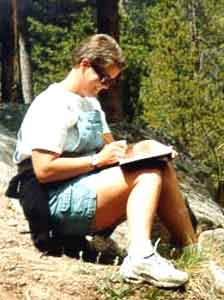 Journaling.
Journaling.
Each day proceeded with students learning about project work as they were experiencing it themselves. This emergent process was very difficult for those students who were used to traditional approaches to learning. Pleasing the teacher, doing everything the "right" way, emphasis on a final project, and grades permeated some students' thinking. One student documented this struggle in her journal:
My frustration level is growing. I am still not fully understanding the process. I feel a need in my learning to know the whole process and what is our end project going to look like. I want to skip exploring, research, documentation, etc., and just start to work on the panel. It's been hard for me to just lay back and follow the process.
Today, I am feeling better about the process. We actually started creating some of our documentation and lining up our panel. This has been a GREAT experience doing this process one step at a time. I now feel I am understanding the process more. I feel we may be jumping around the stages a little, but I am learning so much.
I am frustrated again today. I am learning the process, but every time I think I know what I am doing, I learn something different. I am really learning. I enjoy this way of learning, although I am very frustrated.
Well, it's done—how wonderful it is to have finished such a wonderful project. I still have that feeling, "Did we do it right?"—part of my personality, my insecurity for learning, and need for perfection.
To support learning, daily discussions and mini-lectures covered various aspects of the Reggio Emilia approach and the Project Approach, including the barriers to implementation. One of the barriers identified was meeting educational standards. To assist students in exploring this concern, we provided Head Start outcomes, standards from professional organizations, and state standards for K-3 grades. In small groups, students examined the standards and determined ways to meet them using project work. We were surprised to find that in many cases these active practitioners had not seen the standards that governed their programs and had only received interpretations from a supervisor. This exercise was followed by a discussion about where rules and standards originate, program requirements versus state and federal requirements, and the ability to act as a change agent based upon the origin of the requirement. We referred students to articles that would assist them in examining these issues (see Schuler [2000],http://ecrp.illinois.edu/v2n1/schuler.html; and Helm & Gronlund [2000], (http://ecrp.illinois.edu/v2n1/helm.html). Several students commented that they could definitely see how to meet and exceed the standards governing their program while implementing practices based upon Reggio Emilia and project work.
Cognitive Discourse
As the students engaged in the process of learning, conflict among some members of the groups began to emerge. Although the students believed that it was important for children to get along with one another and to support and guide them in the process, when they did not get along, some had a difficult time applying their beliefs and practices to members of their group. A few members stated:
I felt like there was a dominant group member who did not value my opinion or my work—at least that is how it felt to me. Unfortunately, I had trouble expressing myself to her. I am a pretty quiet person, and I did not want to cause any hard feelings among us because we were working together on the same project. I definitely have trouble leaving my comfort zone.
One of my biggest challenges was not being listened to. I felt like some people in our group were trying to make all of the decisions without taking everyone's ideas into account. I discovered that it was difficult for me to speak up and express myself and my concerns.
Certainly, the group work was challenging for me. I especially had a difficult time when it came to summarizing the experiences and pulling together the documentation. I have very definite ideas and feel strongly about them. I like to keep focused on the topic and course expectations, and I feel resentment from people for ruining the fun.
Disagreement among adults was not a part of their culture; therefore, the tendency was to avoid conflict and not address the conflict when it occurred. Some students confided concerns privately to the instructors and in the journal writing.
We shared with the students that teachers in Reggio Emilia schools view intellectual conflict as an enjoyable process, involving negotiation that leads to growth (Jones & Nimmo, 1999; Nimmo, 1998). For example, one component of negotiated learning is that of discourse, whereby teachers struggle to understand each other, experience conflict, and reflect upon various perspectives (Forman & Fyfe, 1998). Students were surprised to learn that while engaged in discourse, the teachers in the Reggio Emilia schools argue and raise their voices. In addition, teachers value sociocognitive conflict among children and focus on ways to increase opportunities for them to experience conflicting and confusing perspectives. By creating "disturbances" in the environment, teachers can support the challenges occurring among children while providing them with opportunities to "revisit, revise, and review their theories and hypotheses" (New, 1998, p. 272).
We continued to grapple with the conditions that were needed to support conflict among the students. We worked hard to model democratic participation, collaboration, and conflict resolution. For example, we have different teaching styles and points of view, do not always agree but listen carefully, and respect each other. We encouraged the students to reflect upon their conflicts (e.g., Are you listening to the voice of each member of your group?); suggested that they engage in dialogue, debate, and discourse; and trusted that they would work toward negotiating issues of concerns. A few members shared:
Teachers must work hard to feel comfortable with conflict in order to build a sense of community and cohesion among themselves and children. To do so, I must discuss and negotiate. I am working on it and will continue to do so.
By taking time to really talk with a person in my group about an issue that at first we did not agree upon, and listen and reflect, I began to change my belief and found that it was closer in line with hers. I began to reach a different level of understanding, and in doing so, it reaffirmed the importance of discourse and negotiation.
I have thought a lot about my work and interactions with children. Sometimes when I request that a child do something that I think is reasonable and he or she resists, I get frustrated. Now I am experiencing feelings of frustration because a group member is requesting that I do something that I do not want to do. Experiencing this resistance in me has really made me think about the power that I sometimes try to exert over children.
These experiences stimulated our thinking on how to continue to address issues of collaboration and conflict among the students the next time we teach the course. We want to highlight the "necessity" of conflict within groups; encourage the use of conflict resolution strategies; support collaboration; and provide time for processing thoughts through debate and disagreement, through discussion, and in journal writing.
Concluding the Project
The final phase of the course focused on the culmination of the students' weeklong project work. During this phase, many benefits to the adult learners emerged. They viewed themselves as learners and gained confidence in engaging in emergent learning based on their interests rather than on predetermined themes. They delighted in their abilities to investigate phenomena of interest, answer questions, and solve problems. They articulated and summarized what they had learned by consolidating and integrating their shared experiences.
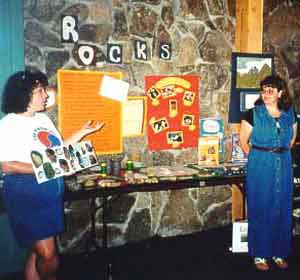 Culminating
event.
Culminating
event.
On the final day, groups presented their projects and documentation to the large group. One student reflected, "It's early morning, and I'm sitting at our project's central piece, contemplating the next step. We have truly put our hearts and souls into this experience, I feel. The next step is just so exciting! Having people check out our work and discuss it. I hope it causes at least one person inspiration for their next project." Because the projects varied, so did the culminating events. Acting out the events that caused the current area geographic conditions, reproducing a rainstorm, identifying plants, rock rap with rock instruments, and an edible plants feast were a few of the events in which we all participated.
 Geologic
dramatization.
Geologic
dramatization.
The groups had bonded, sharing intense experiences together away from families, televisions, phones, shopping centers, and day-to-day responsibilities. They had communed with nature, learned new concepts and ideas about Reggio Emilia, the Project Approach, documentation, and their project of choice. Many had taken new risks, uncovered hidden talents, and learned new things about themselves as reflected in their journal writings:
I can sculpt and I've never done that before.
I learned to trust my potential, to allow myself to explore the present moment to the fullest, with wonderment and joy. By discarding the boundaries of time, expectations, the past and the future, I became fully aware of how learning can be a process, rich with joy, full of depth and inspiration, and most importantly a resource for sharing, communication, and bonding.
I learned acceptance, tolerance, respect, teamwork, and to be resourceful.
Although tired after an intense week, many were sad to leave. "We're almost done. Is that a bit of sadness I am sensing in all the women here this morning? Anxious to go home, yes, but still a little sadness. I'm anxious to get home although I believe this experience will turn out to be one of those memories I choose to revisit in quiet moments."
Final Reflections
After the completion of the course, we spent time reflecting upon and discussing our experiences. We enjoyed the opportunity to engage in a collaborative approach to teaching adults in an intensive setting. At times, we took responsibility for organizing and sharing content and topics of interest to each of us, while at other times, we shared information in a collaborative manner. We particularly enjoyed meeting regularly with students in small groups, getting to know them as individuals, learners, and professionals. Further, we debated issues with each other and with the students and role-modeled our different, yet complementary, styles of teaching.
Through careful observation, interactions, and written feedback, we learned many things about and from the students. We noticed that the majority of them became fully engaged in the course and in their group project work, often working late into the night. As one student shared, "By having large blocks of time and continual access to the professors and peers, the course provided a deep sense of learning about engaging in project work and documenting our experiences." Many students shared that they believed they gained a much richer and deeper understanding of the content in the intensive format because they were focused, engaged, energized, inspired, and lacked "outside distractions." Another student shared, "Even though we were under the pressure of time (because it was an intensive), we were given freedom to explore and because of that, each one of us made the most out of the present moment. The terminology 'intensive' is highly appropriate because I used my cognitive, creative, and social skills to the fullest; much more than I would have during the course of a semester!"
After the completion of the course, we continued to remain in contact with many of the students. We observed them in their early childhood settings, corresponded through the electronic discussion list, and received feedback from a survey reporting changes to their classroom settings based upon their learning in the course. We learned that many of them continue to work toward implementing their "first steps" (Hendrick, 1997) in creative and varied ways. For example, in several of our observations of early childhood settings, we saw examples of webbing and KWHL charts; children working together in small groups on their projects and creating representations through drawings, wire and clay sculpting, and watercoloring; teachers using digital cameras and recording narratives to document children's work; and rich documentation displayed in entryways and classrooms. In other settings, teachers had moved from using predetermined yearly themes to an emergent curriculum that included project work; revised their schedules to provide for longer blocks of time and rearranged their spaces to provide for larger areas for children to engage in project work; and introduced new materials to the children such as "loose parts" (Weisman Topal & Gandini, 1999), mirrors, and baskets full of natural materials to touch and explore.
Interestingly, at the beginning of the course, we received an unanticipated request from one student who was particularly interested in audiovisual technology and wanted to document the course. We were happy to support and encourage her interest, and we all enjoyed sharing our collective experiences with her. She has recently completed a professional editing of the tape, which she titled Creativity and the Young Child: An Adult Learning Experience, and plans to use it in a session at the state early childhood conference.
Responses from the student surveys also provided us with some interesting insights. One teacher shared, "The institute helped me to become a better team-teacher. I have really enjoyed working with the staff and becoming involved with the children on a whole new level. It is so rewarding to observe them, talk about their interests and questions, and figure out how to meet their needs through project work. The children and families are really engaged."
Another respondent to the survey shared, "I have used my knowledge from the summer course to conduct training sessions for early childhood educators on project work and documentation. My co-teacher and I utilized our knowledge to guide our teaching whereby participants engaged in their own mini-projects and experiential learning. Knowledge should be transformative, and I am pleased to say that the summer course assisted me in that outcome!"
Other participants discussed difficulty implementing the approach. In some programs, frequent turnover in staff creates a continual state of crisis, making it difficult to implement any new approaches. In others, the increased emphasis on outcomes and standards has made directors fearful of trying anything new. Others students have become discouraged when they tried to implement too many new ideas at once. As one student stated:
It's not very often I get this excited and optimistic about returning to the classroom in the fall. The great ideas that have flowed in this atmosphere have been stimulating. I don't know if I can get any more excited and inspired without spontaneously combusting. I think that I'm going to have to rein myself in a little bit. I'm getting the urge to go back and do the best and be the best, but I need to go slowly. I do not wish to become discouraged or burnt out.
We've observed that those who have been most successful in implementation have a stable setting, open-minded director, and co-workers who are also interested in the approach. In many programs, staff who have previously attended the course encourage others in the program to enroll. In these programs, we witness continual growth in implementation.
The course itself emerges each time we teach it, based upon the background knowledge and interests of the participants and also upon the collective knowledge of the profession and ourselves. As observers and participants in the course, we continually reflect upon what we will do differently the next year. For example, after witnessing the conflict that occurred in groups over the years, we addressed conflict this year by discussing the notions of collaboration, conflict, discourse, and change; establishing a peace table; developing group-building activities; and revisiting communication tools such as "I" messages, reflective listening, and conflict resolution.
We continue to reflect upon and ask many questions. How can we continue to support the student in implementation of project work? Should we be including information about the change process in the course? Can we continue to provide experimentation as a basis in other early childhood courses? What coursework lends itself best to an intensive format? Are intensive formats more conducive for some students than others?
As professors, we have experienced the value of collaboration and conflict, the challenges in "trusting in the process," and experiential learning in an intensive setting. We modeled team-teaching, discourse, and "practicing what we preach." As stated by one student, "We too, want to become advocates, educators, facilitators, and lifelong learners in our quest to put into practice the Project Approach to teaching." We share our experience not because we believe that our course should be replicated, but because we hope that by telling our story others may find aspects that will inspire them to examine course development and implementation in their respective settings.
References
Carter, Margie, & Curtis, Deb. (1996). Spreading the news: Sharing the stories of early childhood education. St. Paul, MN: Redleaf Press. ED 400 044.
Duckworth, Eleanor. (1996). "The having of wonderful ideas" and other essays on teaching and learning (2nd ed.). New York: Teachers College Press. ED 396 965.
Forman, George, & Fyfe, Brenda. (1998). Negotiated learning through design, documentation, and discourse. In Carolyn Edwards, Lella Gandini, & George Forman (Eds.), The hundred languages of children: The Reggio Emilia approach—Advanced reflections (2nd ed., pp. 239-260). Greenwich, CT: Ablex. ED 425 855.
Gandini, Lella. (1997a). The Reggio Emilia story: History and organizations. In Joanne Hendrick (Ed.), First steps toward teaching the Reggio way.. Columbus, OH: Prentice Hall.
Gandini, Lella. (1997b). Foundations of the Reggio Emilia approach. In Joanne Hendrick (Ed.), First steps toward teaching the Reggio way. Columbus, OH: Prentice Hall.
Helm, Judy Harris, and Gronlund, Gaye. (2000). Linking standards and engaged learning in the early years. Early Childhood Research & Practice [Online], 3(2). Available:http://ecrp.illinois.edu/v2n1/helm.html[2002, November 1].
Helm, Judy Harris, & Katz, Lilian G. (2001). Young investigators: The project approach in the early years. New York: Teachers College Press. ED 448 856.
Hendrick, Joanne (Ed.). (1997). First steps toward teaching the Reggio way. Columbus, OH: Prentice Hall.
Jones, Elizabeth, & Nimmo, John. (1999). Collaboration, conflict, and change: Thoughts on education as provocation. Young Children, 54(1), 5-10. EJ 584 422.
Katz, Lilian G., & Chard, Sylvia C. (2000). Engaging children's minds: The project approach (2nd ed.). Stamford, CT: Ablex. ED 456 892.
Katz, Lilian, & Chard, Sylvia C. (1996). The contribution of documentation to the quality of early childhood education [Online]. ERIC Digest. Champaign, IL: ERIC Clearinghouse on Elementary and Early Childhood Education. Available: http://ecap.crc.illinois.edu/eecearchive/digests/1996/lkchar96.html [2002, October 31]. ED 393 608.
Knowles, Malcolm S. (1980). The modern practice of adult education: From pedagogy to andragogy. Chicago: Association Press.
Knowles, Malcolm, S. (1984). The adult learner: A neglected species (3rd ed.). Houston, TX: Gulf. ED 084 368.
Malaguzzi, Loris. (1998). History, ideas, and basic philosophy: An interview with Lella Gandini. In Carolyn Edwards, Lella Gandini, & George Forman (Eds.), The hundred languages of children: The Reggio Emilia approach—Advanced reflections (2nd ed., pp. 49-97). Greenwich, CT: Ablex. ED 425 855.
New, Rebecca. (1998). Theory and praxis in Reggio Emilia: They know what they are doing and why. In Carolyn Edwards, Lella Gandini, & George Forman (Eds.), The hundred languages of children: The Reggio Emilia approach—Advanced reflections (2nd ed., pp. 261-284). Greenwich, CT: Ablex. ED 425 855.
Nimmo, John. (1998). The child in community: Constraints from the early childhood lore. In Carolyn Edwards, Lella Gandini, & George Forman (Eds.), The hundred languages of children: The Reggio Emilia approach—Advanced reflections (2nd ed., pp. 295-312). Greenwich, CT: Ablex. ED 425 855.
Schuler, Dot. (2000). The project approach: Meeting the state standards. Early Childhood Research & Practice [Online], 3(2). Available:http://ecrp.illinois.edu/v2n1/schuler.html [2002, November 1].
Weisman Topal, Cathy, & Gandini, Lella. (1999). Beautiful stuff: Learning with found materials. Worcester, MA: Davis Publications.
Author Information
Julie Bullard, Ed.D., is an early childhood professor and director of the Early Childhood Education Department at the University of Montana-Western. Current research interests include ADHD and its impact on children and families, the Reggio Emilia approach, and transformative and constructivist education within early childhood higher education.
Julie
Bullard
Director, ECE Department
University of Montana-Western
710 South Atlantic
Dillon, MT 59725
Telephone: 406-683-7176
Fax: 406-683-7809
Email: j_bullard@umwestern.edu
Janis R. Bullock is an early childhood education professor at Montana State University, Bozeman. Her research interests focus on applying early childhood practices to adult education; international and cross-cultural early childhood perspectives; and supporting the social and emotional development of children who report loneliness, being bullied, and rejection by friends.
Janis
R. Bullock
Department of Health and Human Development
Herrick Hall
Montana State University
Bozeman, MT 59717
Telephone: 406-994-5006
Fax: 406-994-2013
Email: jbullock@montana.edu
Appendix
I
Guidelines and Practical Considerations for Selecting Topics
Is the project concrete, interesting, and relevant to the children?
Is the project dense in potential meanings, both emotionally and intellectually?
Are children treated as serious investigators? Does the project allow children to learn and apply basic skills and dispositions (that are consistent with national standards)?
Is the project rich in possibilities?
Does the project allow for varied activities during different parts of the day?
Is the project able to sustain long-term interest?
Is there potential for representation in a variety of media?
Is the project sensitive to the cultural context of children and families?
Is the project familiar to children?
Is the teacher knowledgeable about the topic?
Are there ample resources available?
Does the project lend itself to being emergent and negotiated?
Appendix
II
List of Materials Included in the Studio
| Clay-earth
and modeling Clay tools Colored wire Wire Wire cutters Pliers Cotton balls Metallic shredded paper Markers Watercolors Watercolor pencils Watercolor boards Watercolor brushes Watercolor trays Colored pencils Colored chalk Pencils/pens Pencil sharpener Charcoal Pipe cleaners Crayons Tempera paints Paint containers Oil pastels Felt Foamees Fabric Needles and thread Toothpicks Colored Popsicle sticks Scissors—plain and decorative Mat board Charcoal paper Tissue paper Watercolor paper Tracing paper Assorted colored copy paper Assorted construction paper Waxed paper Tinfoil |
Butcher
paper Manila paper Computer printing paper Yarn Glue sticks Glue gun String Elmers glue Plastic and glass jars Staplers Paper punch Assorted tapes Pushpins Box knife Rubber cement Mounting tape Double stick tape Food coloring Magnifying glasses—assorted types Buckets Rulers Trowel Eye droppers Nets Geology magnifying glasses Computer Reference disks Ink jet paper Computer disks Digital cameras Color printer Lens cleaner Clipboards Journals Baskets Tablecloths Resource books Forest service posters Songbooks |

